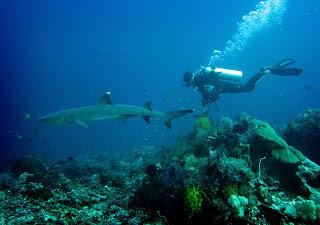
During August, Wicked Diving have been running special shark education trips on our liveaboard. The education trips are designed to inform our guests about sharks in general, their senses, how they swim, the threats they are facing and what can be done by everyone to help save sharks.
In the Komodo National Park we see several different sharks on the majority of our dives! Here’s a little overview of the more common species that we can find here.
White Tip Reef Sharks
Photo by:Jo Marlow
White tip reef sharks live close to the reef. Often during the day they hide in crevices and especially when they are young they rest underneath table corals. They are one of the sharks that don’t need to keep on swimming to breath, they can use a technique called buccal pumping. So they can actively pump water over their gills to breath. It doesn’t mean though that we only see them resting, often we see them cruising along the reef slope. They have a very slender body and a white tip on the dorsal and caudal fin.
Photo by Monika RichterBlack tip Reef Sharks
Black tip reef sharks are a bit more stocky sharks. We see them cruising by close to the reef slopes and sandy bottoms. They blend in really well with the surrounding. Often we see little baby black tips in very shallow water close to the beach. Baby black tips grow up close to mangroves where they are protected from predators. They have a black tip on the dorsal and caudal fin. They are light grayish in colour and get up to a maximum length of 2 meters.
Photo by: Nathalie Perroud
Grey Reef Sharks
Grey Reef sharks we see on a more irregular basis. They are fatter sharks that hang out more in current areas and on deeper slopes. When they visit the reef at our depths the current is often strong like at Castle Rock. They tend to travel further than black and white tip reef sharks. Grey reef sharks are impressive sharks, with black edges on their caudal fin and pectoral fins.
Photo by Eiko GramlichTawny Nurse Sharks and Brown Banded Bamboo Sharks
The tawny nurse shark and the brown banded bamboo sharks are our bottom dwelling (benthic) sharks. They have a tail that gives them more stability then their pelagic cousins. We see the bamboo shark on a regular basis on Karang Makassar. They can be up to about 1,18m in length, whilst tawny nurse sharks can become just over 3 meters. The bamboo sharks are brown banded when they are young.
All of our sharks feed on bony fish (like squirrelfish, parrotfish, damselfish, snappers) but also on crustaceans (like crabs, shrimps and lobsters) and cephalopods (like octopus and squid).
All of our sharks are listed as either Near threatened or Vulnerable on the IUCN Red List. Sharks get fished out as bycatch and targeted mainly for Shark Fin Soup served in China. Only 5% of the shark’s body gets used for the soup (their fins) and they are caught in a horrible way. Sharks get fished out, their fins get cut off and the rest of the body gets thrown back into the sea. This is all done whilst the shark is still alive. Thankfully lots of initiatives are done world-wide to save sharks. But despite these good efforts, it’s still important to raise awareness and keep on trying to make a difference and try to stop these horrible finning activities. Sharks are incredibly important for the eco system as a whole. If we fish too many sharks out, we will have an over population of fish that feed on plankton. That means there will not be enough plankton left to provide oxygen. Did you know that 80% of the oxygen that we use on land comes from our oceans?
So next year we will provide more shark education trips, they are good fun! We collect data for Shark Savers to get an idea of the amount and types of sharks we see in the Komodo National Park. You can become a SSI Shark Diver and with coming on our trips we can show that a shark alive is a lot more valuable than a shark fin in a soup. So by coming on our trip you have helped already to save sharks!
-Wicked Diving Komodo